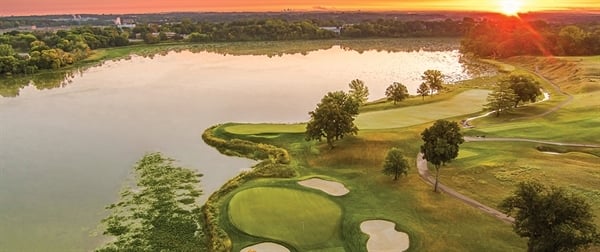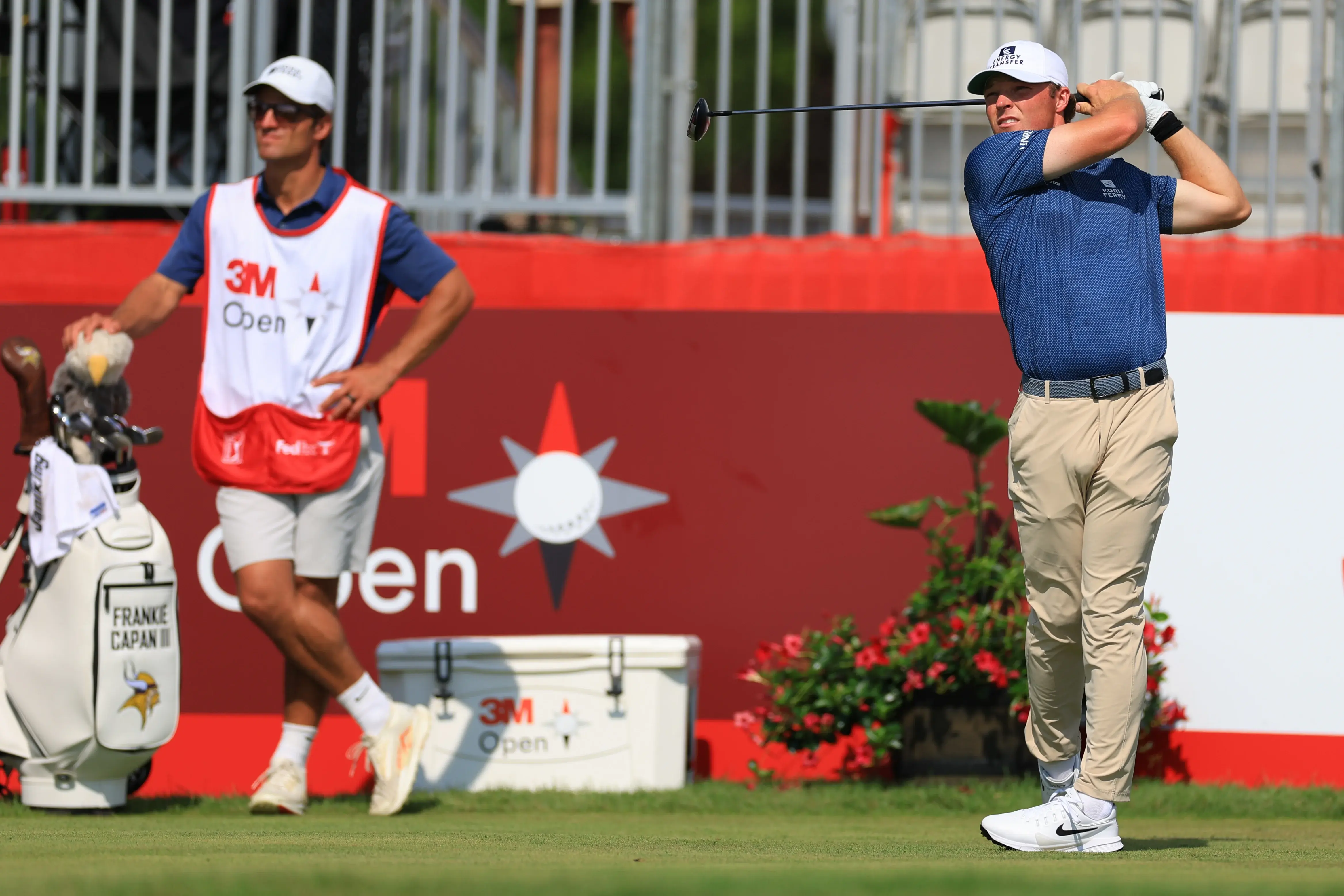Capan Misses Cut in Final Tour Event to Finish Rookie Season 127th in FedEx Cup Standings
SEA ISLAND, Ga. – Following the best individual performance during his rookie season on the PGA Tour last week, Minnesotan Frankie Capan missed the...

It's no secret that Hazeltine National Golf Club has an iconic championship pedigree. Only Pinehurst No. 2 in the North Carolina sandhills, site of this year's U.S. Open, can also boast of hosting the U.S. Open, U.S. Women's Open, U.S. Senior Open, PGA Championship and Ryder Cup matches. (Both Cherry Hills in Colorado and Winged Foot in Westchester County, New York, are only missing the latter.)
And when the KPMG Women's PGA Championship (2019) is added to the equation, Hazeltine stands alone atop the pantheon of these championship sites.
That was the modus operandi when the club's founders, which included former USGA president Totton P. Heffelfinger, decided to turn 350 acres of farmland 26 miles southwest of downtown Minneapolis into a world-class venue that had the capability to test the game's best players.
Renowned architect Robert Trent Jones Sr., with some healthy revisions over time, succeeded in creating a layout that has been the site of two U.S. Opens (1970, 1991), a pair of U.S. Women's Opens (1966, 1977), a U.S. Senior Open (1983), two PGA Championships (2002, 2009), a U.S. Amateur (2006) and a Ryder Cup (2016).
Four years ago, Hazeltine was set to host its seventh USGA championship—it also was the site of the 1994 U.S. Mid-Amateur and 2001 Men's State Team—when a worldwide pandemic stepped in and postponed the U.S. Junior Amateur. But despite COVID-19 preventing that competition from being played, the membership didn't have to wait too long for another USGA reunion.
Preparing for an Epic Return
This August, 312 of the world's premier amateurs will descend on Hazeltine—and nearby stroke-play co-host Chaska Town Course—for the playing of the 124th U.S. Amateur Championship.
“At just short of 7,600 [yards], Hazeltine will very much have the look and feel of a traditional U.S. Open golf course setup,” says Ben Kimball, the USGA's senior director of the U.S. Amateur. “We intend this to be the toughest test of golf that these elite amateurs will face all year, and it will serve as a total examination of not only one's playing ability but their mental stability as well.”
The country's oldest and most prestigious amateur competition boasts a plethora of legendary champions who have etched their names on the Havemeyer Trophy, including Bob Jones, Arnold Palmer, Jack Nicklaus, Tiger Woods and two Minnesotans—Jimmy Johnston (1929) and John Harris (1993). Harris, a former hockey and golf standout at the University of Minnesota (he helped the Gophers win the 1974 NCAA hockey title), was a member of four USA Walker Cup Teams. He remains the last mid-amateur (25 years and older) to claim the title.
Last year at Cherry Hills Country Club outside of Denver, Nick Dunlap, a standout at the University of Alabama, joined Woods as the only players to have won both the U.S. Amateur and U.S. Junior Amateur titles. Five months later, Dunlap became the first amateur in 33 years to win a PGA Tour event (American Express Championship) and turned pro a week later.
Two years ago, at The Ridgewood Country Club in New Jersey, Carson Herron, a Deephaven, Minnesota, resident, made championship history by becoming the first fourth-generation U.S. Amateur competitor, joining his decorated father, Tim, his grandfather and his great-grandfather (both named Carson). The younger Carson followed his dad to the University of New Mexico, where he's completing his junior season. His aunt, Alissa, won the 1999 U.S. Women's Mid-Amateur, with Tim on the bag.
The path for Herron to compete in his home state was made slightly easier when the USGA significantly altered the qualifying process. Over time, the U.S. Amateur has witnessed an evolution in field makeup and, in some cases, format. For an eight-year period from 1965-72, the competition was conducted at 72 holes of stroke play, a move precipitated by former USGA Executive Committee member William C. Campbell, who believed stroke play was a better way to identify a national champion. Ironically, Campbell won the 1964 U.S. Amateur, the final year of match play until that format returned in 1973. The field was expanded to 312 players in 1989 and seeding based off stroke-play qualifying scores was implemented in 1985. In 2012, the USGA exempted players for the first time based on the World Amateur Golf Ranking®/WAGR®, creating a more global field.
Notable Changes
Last year, the USGA approved the expansion of the WAGR exemption from the top 50 to the top 100. It also added exemptions for champions from amateur competitions conducted by Allied Golf Associations, along with other premier amateur events, meaning the Minnesota Amateur (conducted by the Minnesota Golf Association) champion earns a spot in the field. The championship will also introduce two stages of 18-hole qualifying with criteria in place for players to be exempt from the local stage. Previously, 36-hole qualifiers were held to determine the final field.
“As the number of entries and qualifying sites have continued to increase on a yearly basis, we looked at ways to evolve our structure to ensure the long-term sustainability of qualifying without excessively burdening Allied Golf Associations and host clubs,” says Brent Paladino, the USGA's senior director of championship administration. “These revisions will provide players with additional pathways to our championships through traditional qualifying, expanded exemption categories and performance in state, AGA, regional and national amateur championships.”
Winner's Circle
When Hazeltine hosted its first U.S. Amateur in 2006, the WAGR had yet to be an established metric, but Richie Ramsay, of Aberdeen, Scotland, was exempt by virtue of being a playing member of the 2005 Great Britain & Ireland Walker Cup Team. By week's end, the affable Ramsay left the grounds with more than the Havemeyer Trophy. He found a future life partner on the grounds, meeting Hazeltine employee Angela Hudinski en route to becoming the first Scot in 108 years to win the U.S. Am. The two returned to Hazeltine six years later to exchange wedding vows.
On the course, Ramsay won his first three matches rather comfortably, setting up a quarterfinal encounter with Rickie Fowler, then one of the country's top juniors who had yet to matriculate at Oklahoma State University. Holding a 1-up lead going into the par-3 17th hole, Ramsay's local Hazeltine caddie Thomas Buller accidentally touched the intended line of his putt, resulting in a loss-of-hole penalty. Ramsay eventually prevailed in 21 holes.
The next day, he ousted future U.S. Open champion Webb Simpson, but not without breaching another rule, when he grounded his club before playing a shot from a water hazard (then a loss-of-hole penalty). Ramsay vehemently denied breaking the rule, but after a lengthy discussion with officials, it was deemed that he committed the violation.
The man affectionately called “Rambo” shook off the incident and prevailed, 1 up, to advance to Sunday's 36-hole final against John Kelly.

SEA ISLAND, Ga. – Following the best individual performance during his rookie season on the PGA Tour last week, Minnesotan Frankie Capan missed the...

Players from Minnesota or with Minnesota connections:2025 PGA TOUR Pos. Name (Prev.) From Events Money won 48. Tom Hoge (48), Fargo, N.D., 29...

John Harrigan, 93, passed away at his home in Boynton Beach, Fla., November 15. Originally from Waterloo, Iowa, Harrigan graduated from Stillwater...